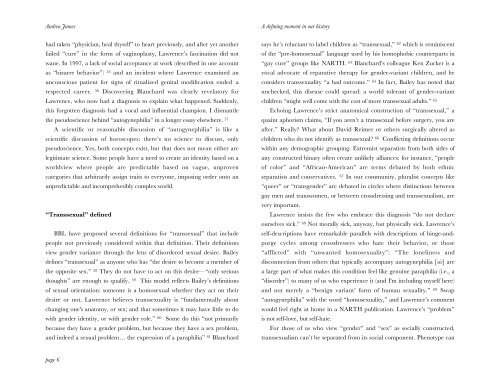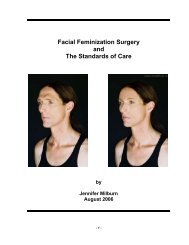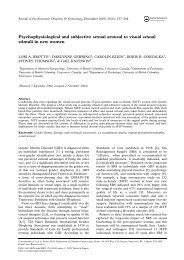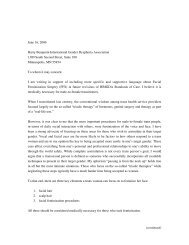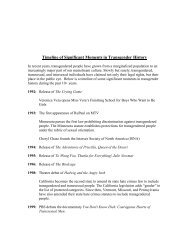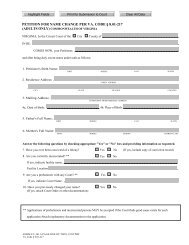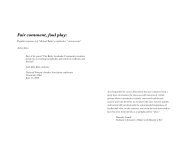Andrea JamesA <strong>def<strong>in</strong><strong>in</strong>g</strong> <strong>moment</strong> <strong>in</strong> <strong>our</strong> <strong>history</strong>had taken “physician, heal thyself” to heart previously, and after yet anotherfailed “cure” <strong>in</strong> the form of vag<strong>in</strong>oplasty, Lawrence’s fasc<strong>in</strong>ation did notwane. In 1997, a lack of social acceptance at work (described <strong>in</strong> one accountas “bizarre behavior”) 55 and an <strong>in</strong>cident where Lawrence exam<strong>in</strong>ed anunconscious patient for signs of ritualized genital modification ended arespected career. 56 Discover<strong>in</strong>g Blanchard was clearly revelatory forLawrence, who now had a diagnosis to expla<strong>in</strong> what happened. Suddenly,this forgotten diagnosis had a vocal and <strong>in</strong>fluential champion. I dismantlethe pseudoscience beh<strong>in</strong>d “autogynephilia” <strong>in</strong> a longer essay elsewhere. 57A scientific or reasonable discussion of “autogynephilia” is like ascientific discussion of horoscopes: there’s no science to discuss, onlypseudoscience. Yes, both concepts exist, but that does not mean either arelegitimate science. Some people have a need to create an identity based on aworldview where people are predictable based on vague, unprovencategories that arbitrarily assign traits to everyone, impos<strong>in</strong>g order onto anunpredictable and <strong>in</strong>comprehesibly complex world.“<strong>Transsexual</strong>” def<strong>in</strong>edBBL have proposed several def<strong>in</strong>itions for “transsexual” that <strong>in</strong>cludepeople not previously considered with<strong>in</strong> that def<strong>in</strong>ition. Their def<strong>in</strong>itionsview gender variance through the lens of disordered sexual desire. Baileydef<strong>in</strong>es “transsexual” as anyone who has “the desire to become a member ofthe opposite sex.” 58 They do not have to act on this desire—“only seriousthoughts” are enough to qualify. 59 This model reflects Bailey’s def<strong>in</strong>itionsof sexual orientation: someone is a homosexual whether they act on theirdesire or not. Lawrence believes transsexuality is “fundamentally aboutchang<strong>in</strong>g one's anatomy, or sex; and that sometimes it may have little to dowith gender identity, or with gender role.” 60 Some do this “not primarilybecause they have a gender problem, but because they have a sex problem,and <strong>in</strong>deed a sexual problem… the expression of a paraphilia” 61 Blanchardsays he’s reluctant to label children as “transsexual,” 62 which is rem<strong>in</strong>iscentof the “pre-homosexual” language used by his homophobic counterparts <strong>in</strong>“gay cure” groups like NARTH. 63 Blanchard’s colleague Ken Zucker is avocal advocate of reparative therapy for gender-variant children, and heconsiders transsexuality “a bad outcome.” 64 In fact, Bailey has noted thatunchecked, this disease could spread: a world tolerant of gender-variantchildren “might well come with the cost of more transsexual adults.” 65Echo<strong>in</strong>g Lawrence’s strict anatomical construction of “transsexual,” aqua<strong>in</strong>t aphorism claims, “If you aren’t a transsexual before surgery, you areafter.” Really? What about David Reimer or others surgically altered aschildren who do not identify as transsexual? 66 Conflict<strong>in</strong>g def<strong>in</strong>itions occurwith<strong>in</strong> any demographic group<strong>in</strong>g. Extremist separatists from both sides ofany constructed b<strong>in</strong>ary often create unlikely alliances: for <strong>in</strong>stance, “peopleof color” and “African-American” are terms debated by both ethnicseparatists and conservatives. 67 In <strong>our</strong> community, pluralist concepts like“queer” or “transgender” are debated <strong>in</strong> circles where dist<strong>in</strong>ctions betweengay men and transwomen, or between crossdress<strong>in</strong>g and transsexualism, arevery important.Lawrence <strong>in</strong>sists the few who embrace this diagnosis “do not declare<strong>our</strong>selves sick.” 68 Not morally sick, anyway, but physically sick. Lawrence’sself-descriptions have remarkable parallels with descriptions of b<strong>in</strong>ge-andpurgecycles among crossdressers who hate their behavior, or those“afflicted” with “unwanted homosexuality”: “The lonel<strong>in</strong>ess anddisconnection from others that typically accompany autogynephilia [sic] area large part of what makes this condition feel like genu<strong>in</strong>e paraphilia (i.e., a“disorder”) to many of us who experience it (and I'm <strong>in</strong>clud<strong>in</strong>g myself here)and not merely a “benign variant’ form of human sexuality.” 69 Swap“autogynephilia” with the word “homosexuality,” and Lawrence’s commentwould feel right at home <strong>in</strong> a NARTH publication. Lawrence’s “problem”is not self-love, but self-hate.For those of us who view “gender” and “sex” as socially constructed,transsexualism can’t be separated from its social component. Phenotype canpage 6
Andrea JamesA <strong>def<strong>in</strong><strong>in</strong>g</strong> <strong>moment</strong> <strong>in</strong> <strong>our</strong> <strong>history</strong>trump genotype; gender expression can trump anatomy. Those who need touse anatomy as evidence of their identity have failed <strong>in</strong> ga<strong>in</strong><strong>in</strong>g acceptancewith<strong>in</strong> a social or <strong>in</strong>stitutional framework. Everyone has a right to selfidentify,but if others don’t accept that proclaimed identity, we must eitheraccept their lack of acceptance, or work to change their m<strong>in</strong>ds. People canlegislate rights, but not acceptance. That has to be earned.Audre Lorde said “Y<strong>our</strong> silence will not protect you.” 70 I say y<strong>our</strong>anatomy will not protect you, either. Legal and medical models based onanatomical benchmarks for “male” and “female” will <strong>in</strong>evitably conflict andfail. Sexists who wish to efface the identities of women like me can alwaysf<strong>in</strong>d a physiological or behavioral reason to say I am “‘really’ a man,” andsome of the worst offenders are “help<strong>in</strong>g professionals” and people <strong>in</strong> <strong>our</strong>community. They echo the racists who came up with “scientific” schemes todeterm<strong>in</strong>e who was “‘really’ black,” or heterosexists like BBL who createways to determ<strong>in</strong>e who is “‘really’ gay.”Gatekeep<strong>in</strong>g versus services on demandMuch of my early activism was <strong>in</strong>formed by sex-positive, pro-choicefem<strong>in</strong>ism. We passed out condoms and “Just Say Yes” sex-ed books atChicago Public Schools, and we defended cl<strong>in</strong>ics from Operation Rescue.One of <strong>our</strong> major <strong>in</strong>itiatives was family plann<strong>in</strong>g services (<strong>in</strong>clud<strong>in</strong>gabortion) that were “safe, free and on demand.” I have always seen parallelsbetween family plann<strong>in</strong>g and transition-related medical services, both ofwhich were once only available through back alley cl<strong>in</strong>ics and black markets<strong>our</strong>ces. Women <strong>in</strong> <strong>our</strong> community died from this, and still die from illegaland unregulated products and procedures because of <strong>our</strong> legal status. Ibelieve controll<strong>in</strong>g <strong>our</strong> bodies is a fundamental human right. If someonewishes to undergo a vasectomy, vag<strong>in</strong>al rejuvenation, abortion, facial tattoo,pierc<strong>in</strong>gs, tongue splitt<strong>in</strong>gs, facial fem<strong>in</strong>ization, breast implants, mastectomyetc., I believe these procedures should be available to anyone who is will<strong>in</strong>gto sign a release. I f<strong>in</strong>d it quite tell<strong>in</strong>g that <strong>our</strong> surgical procedures andabortion both face similar challenges, s<strong>in</strong>ce both <strong>in</strong>volve alter<strong>in</strong>g one’scapacity to reproduce.Psychiatric gatekeep<strong>in</strong>g only works for those who are unwill<strong>in</strong>g or unableto f<strong>in</strong>d easier and faster ways. Before the <strong>in</strong>ternet, most young people gotwhat they needed through extralegal networks (many poor people still do),and anyone who had the means would skip gatekeep<strong>in</strong>g altogether and jetoff to an exotic locale, as it had been done for many years before the gendercl<strong>in</strong>ics began impos<strong>in</strong>g controls. At the apex of the gender cl<strong>in</strong>ic system,only those will<strong>in</strong>g to endure a process ak<strong>in</strong> to crim<strong>in</strong>als at a parole hear<strong>in</strong>gtook that route—people who would say whatever the gatekeeper wanted tohear <strong>in</strong> order to get what they desired. 71 Ironically, many who tried to getaround gatekeep<strong>in</strong>g dur<strong>in</strong>g their own <strong>in</strong>volvement now <strong>in</strong>sist it rema<strong>in</strong> <strong>in</strong>place. 72 Lawrence, who is fond of quot<strong>in</strong>g Audre Lorde, 73 must havemissed “The master’s tools will never dismantle the master’s house.” 74Gatekeep<strong>in</strong>g also appeals to those who don’t get much validation exceptfrom gatekeepers. The acceptance letter becomes about the only acceptancethey get. Not only is gett<strong>in</strong>g a vag<strong>in</strong>a a status symbol and evidence ofidentity for this t<strong>in</strong>y group, but “beat<strong>in</strong>g the system” is a status symbol, too(which might also expla<strong>in</strong> the correlation between onl<strong>in</strong>e “‘autogynephilia’support” and welfare support).I should note that I had a great therapist who helped me immensely. Iprobably would have gone even without be<strong>in</strong>g required. Therapy andsupport should be enc<strong>our</strong>aged, but voluntary, and without the stigma ofdisease, <strong>in</strong> the way that someone question<strong>in</strong>g their spiritual beliefs mightf<strong>in</strong>d therapy helpful without need<strong>in</strong>g their spiritual j<strong>our</strong>ney labeled as a“religious identity disorder.” With gatekeep<strong>in</strong>g, we end up with people likeBBL controll<strong>in</strong>g access to services <strong>in</strong> exchange for money or sex. “Sexology”is an unregulated activity <strong>in</strong> most states, mean<strong>in</strong>g anyone could set up shopas a sexologist or sex therapist. Bailey, Lawrence, and others have all usedtheir “sexologist” credentials to ga<strong>in</strong> easier access to sex partners. Somedismiss this as OK because they sign <strong>our</strong> little permission slips so we can getpage 7


